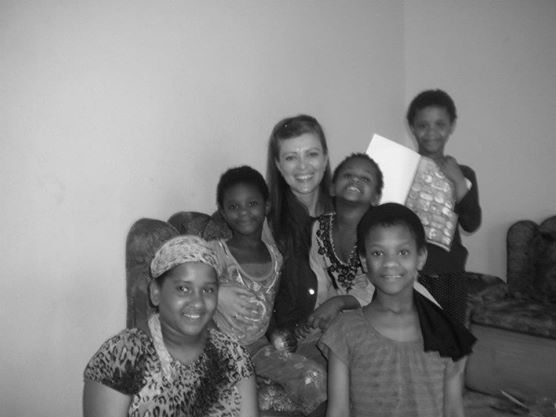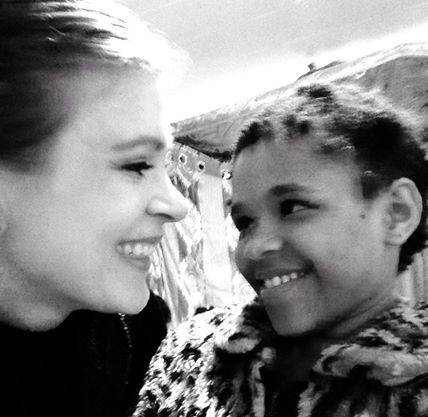thanksgiving is this
Two months after I met the Somali family, the older girls came home from school and told me they’d started learning about the American holiday Thanksgiving at school, and asked me to tell them more about it.
The first explanation I thought of – that every year Americans kill 45 million turkeys to celebrate that half of the Pilgrims who came to America didn’t die during the first winter– sounded ridiculous. So instead of trying to explain it further, I said, “How would you like to celebrate Thanksgiving with me this year?” They were ecstatic.
Every time I went over to their apartment in the weeks leading up to Thanksgiving, they’d race to get their coats and shoes, yelling, “We go to your house TODAY?”
Every time I’d shake my head and say, “Nope, not today.”
On the morning of Thanksgiving, my housemate Betsy and I drove over to their apartment to pick them up – we needed two cars to transport the six of them. When we knocked on the door, the girls all came running. Hadhi opened the door and motioned for us to come inside. I held my arms out and called, “Who wants to go to my house today?” They screamed and clamored to get their shoes on.

I brought a bag filled with hats and mittens, and once they had their shoes and coats on I handed out the items – partly because I thought they might like the thought of getting “dressed up” to come to my place, and partly because they didn’t own any winter gear.
We piled into the two cars, and drove to my townhouse. My other housemate Karrie had made the turkey, and when Betsy and the family and I got home, a bounty of turkey, stuffing, sweet potatoes, green beans, and bread was waiting for us.
We made each person a plate, then sat together in a circle on a blanket in the living room. We gave a quick thanks for the food and for each of them, and then started eating. Just like the night we ate pasta, the girls tried using a fork for a few minutes, and then gave up and used their right hands instead.
Some of the girls ate the new food without question, but Lelo was skeptical. She kept holding up each piece of food and asking, “I can eat this?”
I nodded at each morsel and said, “Yes, it’s okay to eat that.”
Then she’d hold up the next piece, “I can eat this?
Chaki ate well until she caught a glimpse of ice cream in the freezer when I reached in toget some ice cubes. For the rest of the meal, whenever I encouraged her to eat, she looked at me hopefully and raised her eyebrows. “Ice cream?” she asked over and over. “I eat your ice cream?”
When everyone had finished eating, we cleared away the dishes. My friend Karina and her husband Dan came over with their two towheaded, blue-eyed little boys, who were three and six. We all ate dessert together, sitting in a big circle on the living room floor. The girls devoured their “bumpkin pie” and vanilla ice cream, and then played together with their new American friends. Some of them colored together at the dining room table, while some played with a wooden doll house and chairs that were donated by some families at my church.
When it got dark, we decided to pack everyone up and drive them home. It was getting near the girls’ bedtime, and we still had a surprise for them.
Two weeks before Thanksgiving, I spoke about the Somali family at church, and the congregation gave more than a thousand dollars to the Change for a Dollar fund that day. I used the donated money to buy everything Hadhi and the girls needed for their sparse apartment – a futon, a reading chair, a rug, clean clothes, closet organizers, more blankets, pillows, bath towels, cleaning supplies, silverware, and food.
To make the new household supplies more exciting, I decided to give everything to the family on Thanksgiving night, like a small-scale version of Extreme Home Makeover.
My housemates and Karina and I piled Hadhi and the girls, as well as all of the new supplies, in our cars. We drove the caravan from my house to the apartment, and began to unload everything. It was humbling to watch the little girls shriek with excitement over silverware and bath towels.
A few hours later, we’d helped Hadhi clean the kitchen and bathroom with the new cleaning supplies, set up house, bathed the girls, and put everyone in clean clothes. Four of the girls sat together on their new living room rug in their clean pajamas, wrapped up in their fleece blankets, watching The Incredibles.
I went into the bedroom to finish putting their clothes into the closet organizers we’d bought for them, and I found six-year-old Sadaka sitting in the corner. She was not her usual giggling self; instead, she had a pained look on her face, and she held a large, ratty Michael Jordan jersey against her cheek.

“You can’t keep that shirt,” I said as I tried to gently take it from her. “It’s stained, and it’s way too big for you.”
She looked around the room, making sure that her mom and sisters were out of earshot. When she saw that we were alone, she motioned for me to come sit next to her. Then she cupped her hand around my ear, leaned in close, and whispered, “Can I tell you a secret?”
“Of course,” I said.
“This shirt is my dad’s,” she said. “I kept it when he went away.” Still holding the jersey, she climbed into my lap, and tears welled up in her big brown eyes.
“Do you miss your daddy?” I asked her.
She nodded, and her tears spilled onto my shirt.
I kissed the top of her head, and held her for a long time, until she’d finished crying. When she was done, she wiped her eyes with her sleeve, then leaned close to my ear and whispered, “Can I tell you another secret?”
“Of course,” I said. “You can tell me anything.” “I love you, Sahara."
“I love you too, baby.” I hugged her closer. “I love you, too.”
As I drove home that night, I thought about the meaning of the original Thanksgiving, how its participants celebrated that natives were willing to help foreign settlers who’d come to a new country without the means of surviving its perils. I thought about the mixed emotions the Pilgrims must have had that day - the joy that half of their group had survived, and the sadness that half of their group had died.
On the familiar route from the apartment to my house, I thought about how I would explain Thanksgiving to someone if they asked me after tonight.
I decided I would show them the joy of new hats and gloves, a ride in my car, plates of turkey and stuffing eaten by Somali refugee children on a blanket in my living room, and an apartment filled with new clothes and enough supplies to get an African family through a Pacific Northwest winter. And I would show them the sadness of a little girl holding a tattered shirt against her cheek, weeping at the memory of the one who didn’t make it.
This, I would say. Thanksgiving is this.
***
The above is an excerpt from my memoir, The Invisible Girls. All the proceeds from the book go towards a college fund for the Somali girls. To find out more about the story, or to purchase a copy of the book, click here.